Financial Reporting Analysis: Alpha Ltd, UK Manufacturing Company
VerifiedAdded on 2020/10/05
|16
|4265
|255
Report
AI Summary
This report provides a comprehensive analysis of the financial reporting of Alpha Ltd, a UK-based manufacturing company. It examines the regulatory framework, governance, and the purpose of financial reporting in meeting organizational objectives and fostering development and growth. The report interprets key financial statements, including the profit and loss statement, balance sheet, and cash flow statement, and calculates and interprets various financial ratios to assess the company's performance. It also discusses the benefits of International Accounting Standards and International Financial Reporting Standards, explores models of financial reporting and auditing, and evaluates the differences and importance of financial reporting across different countries. The analysis covers the financial performance, liquidity, and solvency of Alpha Ltd, providing insights into its strengths and weaknesses based on the provided financial data.
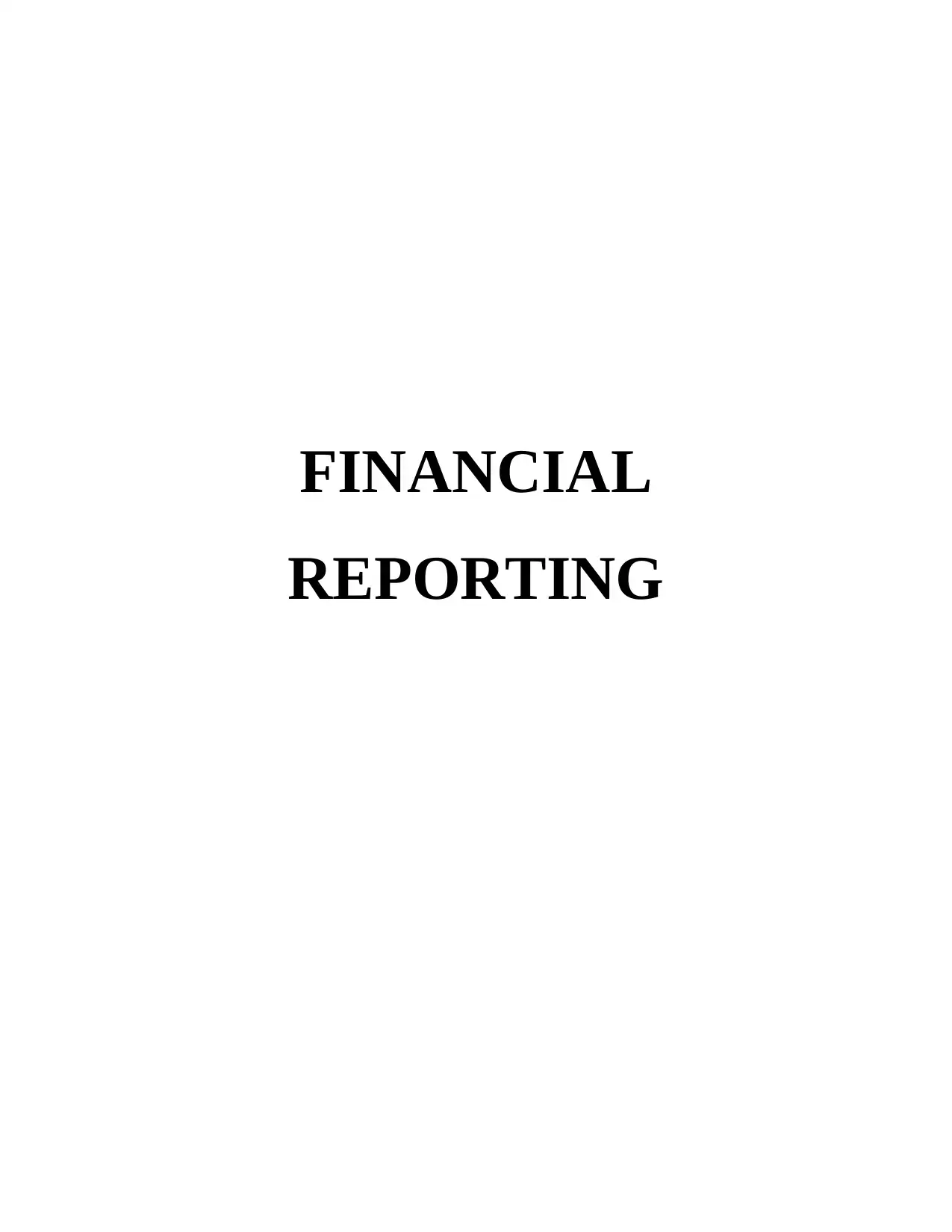
FINANCIAL
REPORTING
REPORTING
Paraphrase This Document
Need a fresh take? Get an instant paraphrase of this document with our AI Paraphraser
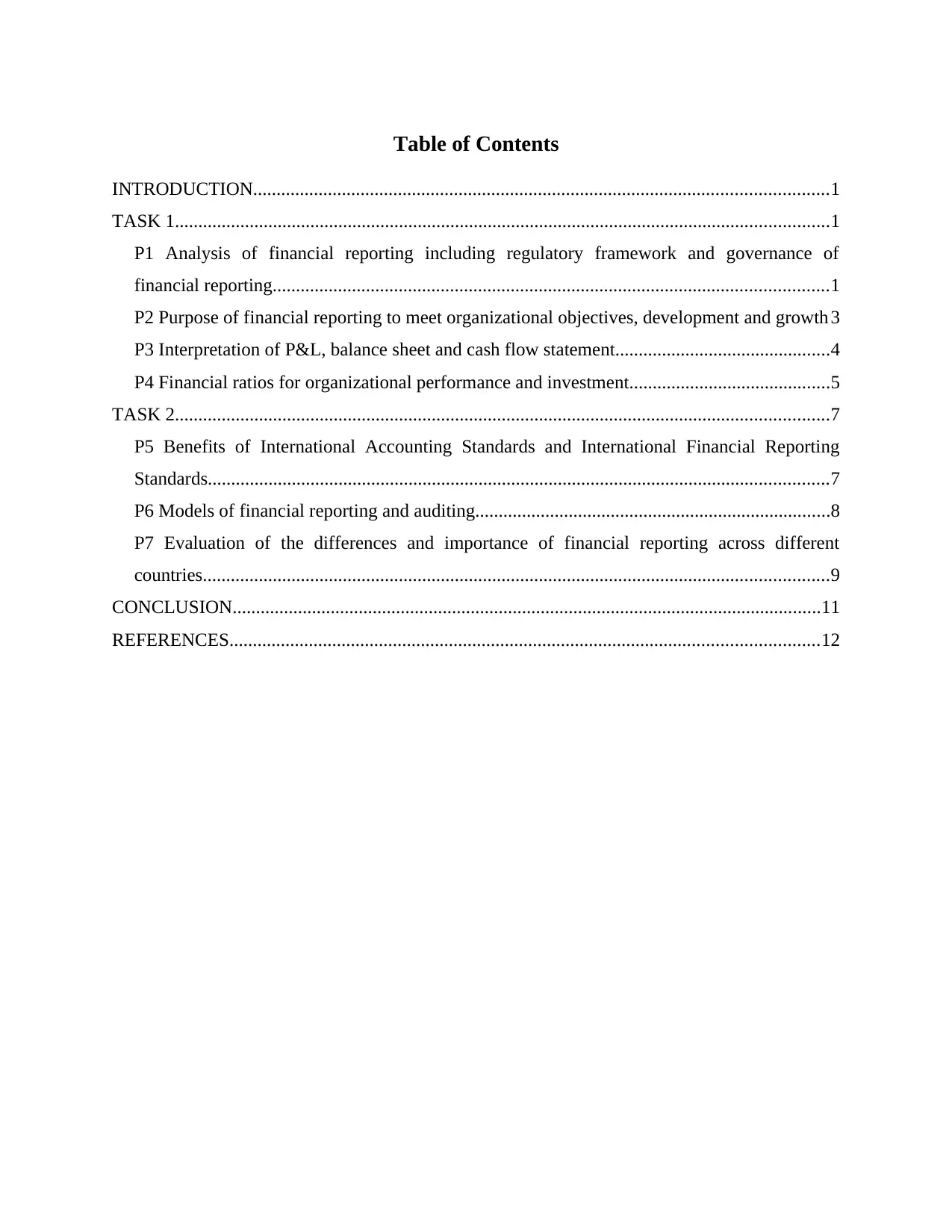
Table of Contents
INTRODUCTION...........................................................................................................................1
TASK 1............................................................................................................................................1
P1 Analysis of financial reporting including regulatory framework and governance of
financial reporting.......................................................................................................................1
P2 Purpose of financial reporting to meet organizational objectives, development and growth 3
P3 Interpretation of P&L, balance sheet and cash flow statement..............................................4
P4 Financial ratios for organizational performance and investment...........................................5
TASK 2............................................................................................................................................7
P5 Benefits of International Accounting Standards and International Financial Reporting
Standards.....................................................................................................................................7
P6 Models of financial reporting and auditing............................................................................8
P7 Evaluation of the differences and importance of financial reporting across different
countries......................................................................................................................................9
CONCLUSION..............................................................................................................................11
REFERENCES..............................................................................................................................12
INTRODUCTION...........................................................................................................................1
TASK 1............................................................................................................................................1
P1 Analysis of financial reporting including regulatory framework and governance of
financial reporting.......................................................................................................................1
P2 Purpose of financial reporting to meet organizational objectives, development and growth 3
P3 Interpretation of P&L, balance sheet and cash flow statement..............................................4
P4 Financial ratios for organizational performance and investment...........................................5
TASK 2............................................................................................................................................7
P5 Benefits of International Accounting Standards and International Financial Reporting
Standards.....................................................................................................................................7
P6 Models of financial reporting and auditing............................................................................8
P7 Evaluation of the differences and importance of financial reporting across different
countries......................................................................................................................................9
CONCLUSION..............................................................................................................................11
REFERENCES..............................................................................................................................12
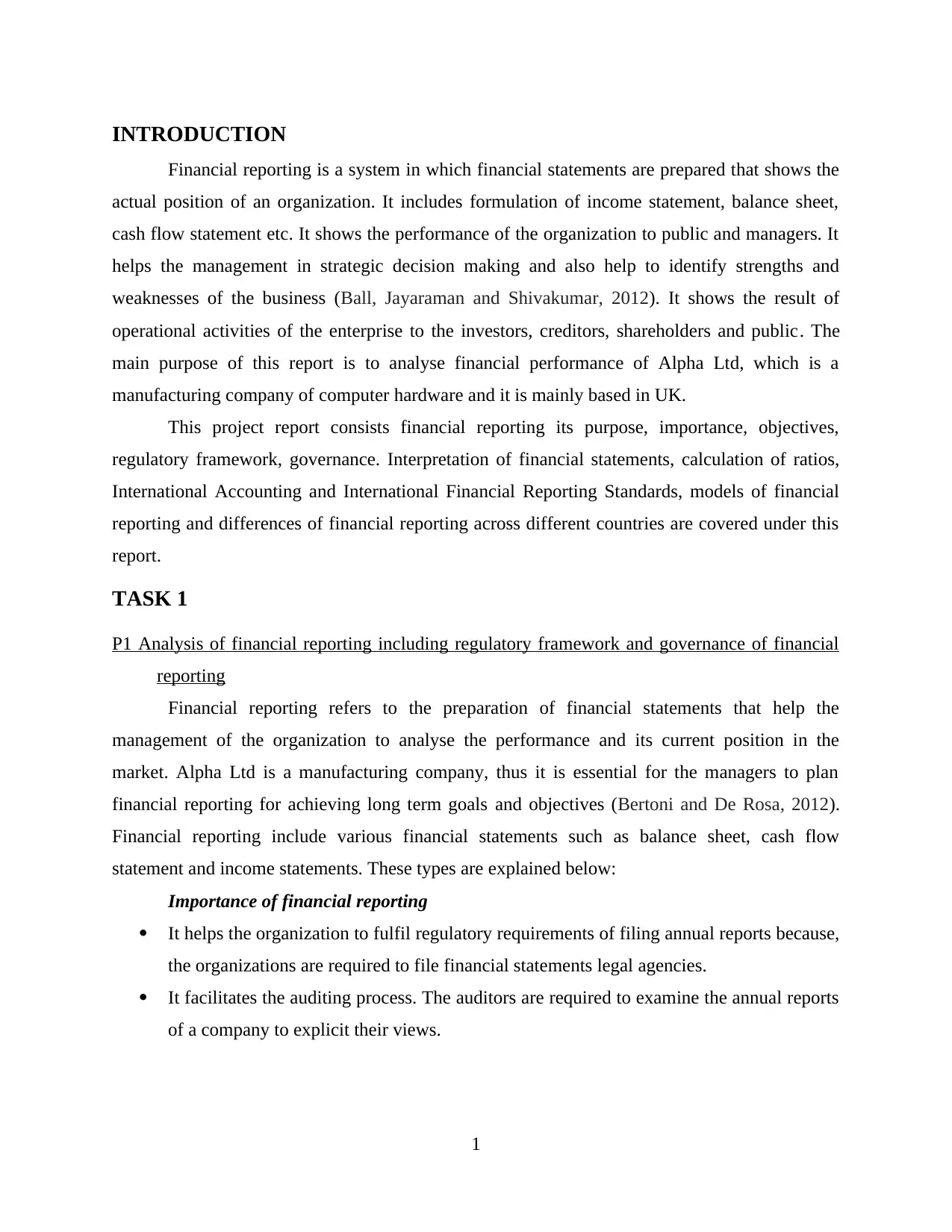
INTRODUCTION
Financial reporting is a system in which financial statements are prepared that shows the
actual position of an organization. It includes formulation of income statement, balance sheet,
cash flow statement etc. It shows the performance of the organization to public and managers. It
helps the management in strategic decision making and also help to identify strengths and
weaknesses of the business (Ball, Jayaraman and Shivakumar, 2012). It shows the result of
operational activities of the enterprise to the investors, creditors, shareholders and public. The
main purpose of this report is to analyse financial performance of Alpha Ltd, which is a
manufacturing company of computer hardware and it is mainly based in UK.
This project report consists financial reporting its purpose, importance, objectives,
regulatory framework, governance. Interpretation of financial statements, calculation of ratios,
International Accounting and International Financial Reporting Standards, models of financial
reporting and differences of financial reporting across different countries are covered under this
report.
TASK 1
P1 Analysis of financial reporting including regulatory framework and governance of financial
reporting
Financial reporting refers to the preparation of financial statements that help the
management of the organization to analyse the performance and its current position in the
market. Alpha Ltd is a manufacturing company, thus it is essential for the managers to plan
financial reporting for achieving long term goals and objectives (Bertoni and De Rosa, 2012).
Financial reporting include various financial statements such as balance sheet, cash flow
statement and income statements. These types are explained below:
Importance of financial reporting
It helps the organization to fulfil regulatory requirements of filing annual reports because,
the organizations are required to file financial statements legal agencies.
It facilitates the auditing process. The auditors are required to examine the annual reports
of a company to explicit their views.
1
Financial reporting is a system in which financial statements are prepared that shows the
actual position of an organization. It includes formulation of income statement, balance sheet,
cash flow statement etc. It shows the performance of the organization to public and managers. It
helps the management in strategic decision making and also help to identify strengths and
weaknesses of the business (Ball, Jayaraman and Shivakumar, 2012). It shows the result of
operational activities of the enterprise to the investors, creditors, shareholders and public. The
main purpose of this report is to analyse financial performance of Alpha Ltd, which is a
manufacturing company of computer hardware and it is mainly based in UK.
This project report consists financial reporting its purpose, importance, objectives,
regulatory framework, governance. Interpretation of financial statements, calculation of ratios,
International Accounting and International Financial Reporting Standards, models of financial
reporting and differences of financial reporting across different countries are covered under this
report.
TASK 1
P1 Analysis of financial reporting including regulatory framework and governance of financial
reporting
Financial reporting refers to the preparation of financial statements that help the
management of the organization to analyse the performance and its current position in the
market. Alpha Ltd is a manufacturing company, thus it is essential for the managers to plan
financial reporting for achieving long term goals and objectives (Bertoni and De Rosa, 2012).
Financial reporting include various financial statements such as balance sheet, cash flow
statement and income statements. These types are explained below:
Importance of financial reporting
It helps the organization to fulfil regulatory requirements of filing annual reports because,
the organizations are required to file financial statements legal agencies.
It facilitates the auditing process. The auditors are required to examine the annual reports
of a company to explicit their views.
1
⊘ This is a preview!⊘
Do you want full access?
Subscribe today to unlock all pages.

Trusted by 1+ million students worldwide
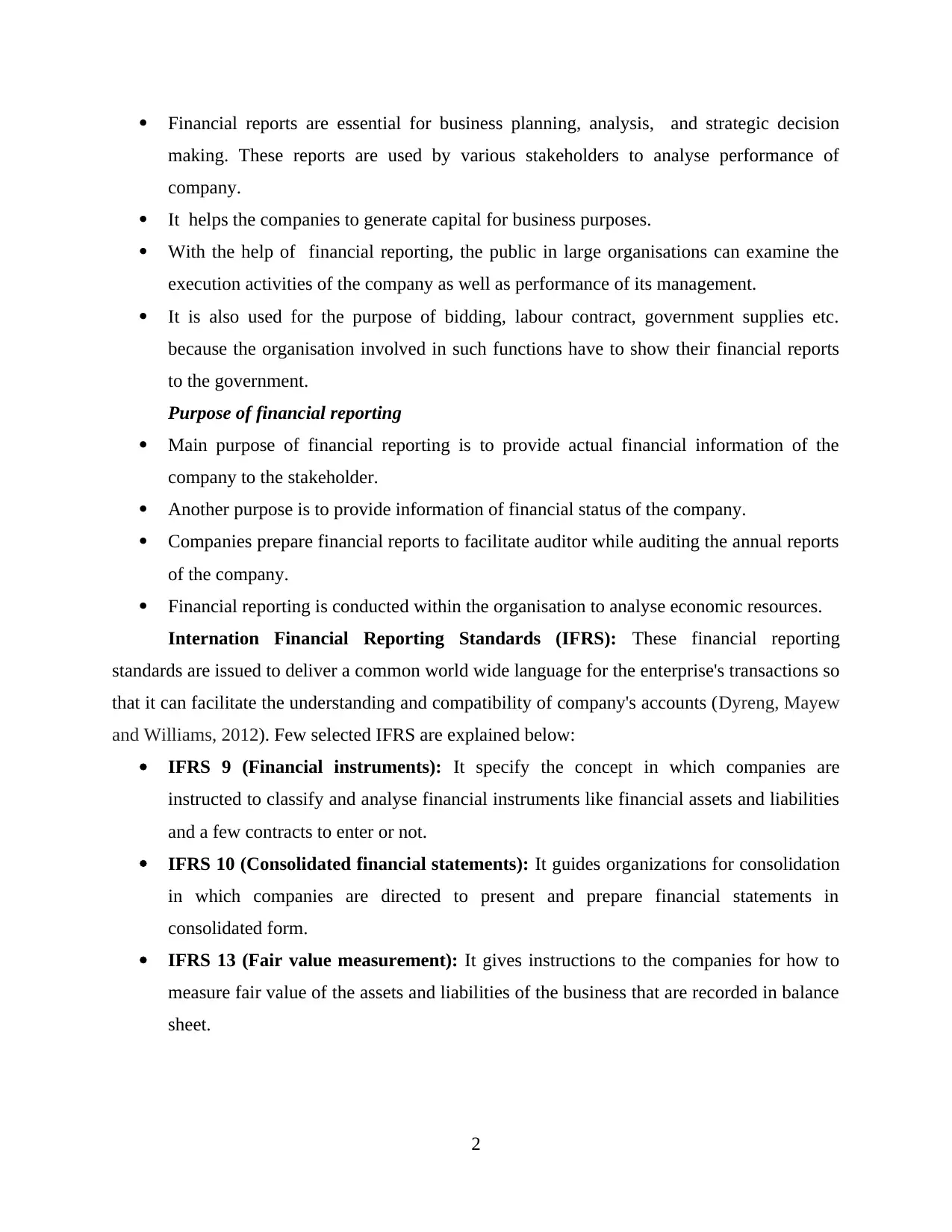
Financial reports are essential for business planning, analysis, and strategic decision
making. These reports are used by various stakeholders to analyse performance of
company.
It helps the companies to generate capital for business purposes.
With the help of financial reporting, the public in large organisations can examine the
execution activities of the company as well as performance of its management.
It is also used for the purpose of bidding, labour contract, government supplies etc.
because the organisation involved in such functions have to show their financial reports
to the government.
Purpose of financial reporting
Main purpose of financial reporting is to provide actual financial information of the
company to the stakeholder.
Another purpose is to provide information of financial status of the company.
Companies prepare financial reports to facilitate auditor while auditing the annual reports
of the company.
Financial reporting is conducted within the organisation to analyse economic resources.
Internation Financial Reporting Standards (IFRS): These financial reporting
standards are issued to deliver a common world wide language for the enterprise's transactions so
that it can facilitate the understanding and compatibility of company's accounts (Dyreng, Mayew
and Williams, 2012). Few selected IFRS are explained below:
IFRS 9 (Financial instruments): It specify the concept in which companies are
instructed to classify and analyse financial instruments like financial assets and liabilities
and a few contracts to enter or not.
IFRS 10 (Consolidated financial statements): It guides organizations for consolidation
in which companies are directed to present and prepare financial statements in
consolidated form.
IFRS 13 (Fair value measurement): It gives instructions to the companies for how to
measure fair value of the assets and liabilities of the business that are recorded in balance
sheet.
2
making. These reports are used by various stakeholders to analyse performance of
company.
It helps the companies to generate capital for business purposes.
With the help of financial reporting, the public in large organisations can examine the
execution activities of the company as well as performance of its management.
It is also used for the purpose of bidding, labour contract, government supplies etc.
because the organisation involved in such functions have to show their financial reports
to the government.
Purpose of financial reporting
Main purpose of financial reporting is to provide actual financial information of the
company to the stakeholder.
Another purpose is to provide information of financial status of the company.
Companies prepare financial reports to facilitate auditor while auditing the annual reports
of the company.
Financial reporting is conducted within the organisation to analyse economic resources.
Internation Financial Reporting Standards (IFRS): These financial reporting
standards are issued to deliver a common world wide language for the enterprise's transactions so
that it can facilitate the understanding and compatibility of company's accounts (Dyreng, Mayew
and Williams, 2012). Few selected IFRS are explained below:
IFRS 9 (Financial instruments): It specify the concept in which companies are
instructed to classify and analyse financial instruments like financial assets and liabilities
and a few contracts to enter or not.
IFRS 10 (Consolidated financial statements): It guides organizations for consolidation
in which companies are directed to present and prepare financial statements in
consolidated form.
IFRS 13 (Fair value measurement): It gives instructions to the companies for how to
measure fair value of the assets and liabilities of the business that are recorded in balance
sheet.
2
Paraphrase This Document
Need a fresh take? Get an instant paraphrase of this document with our AI Paraphraser
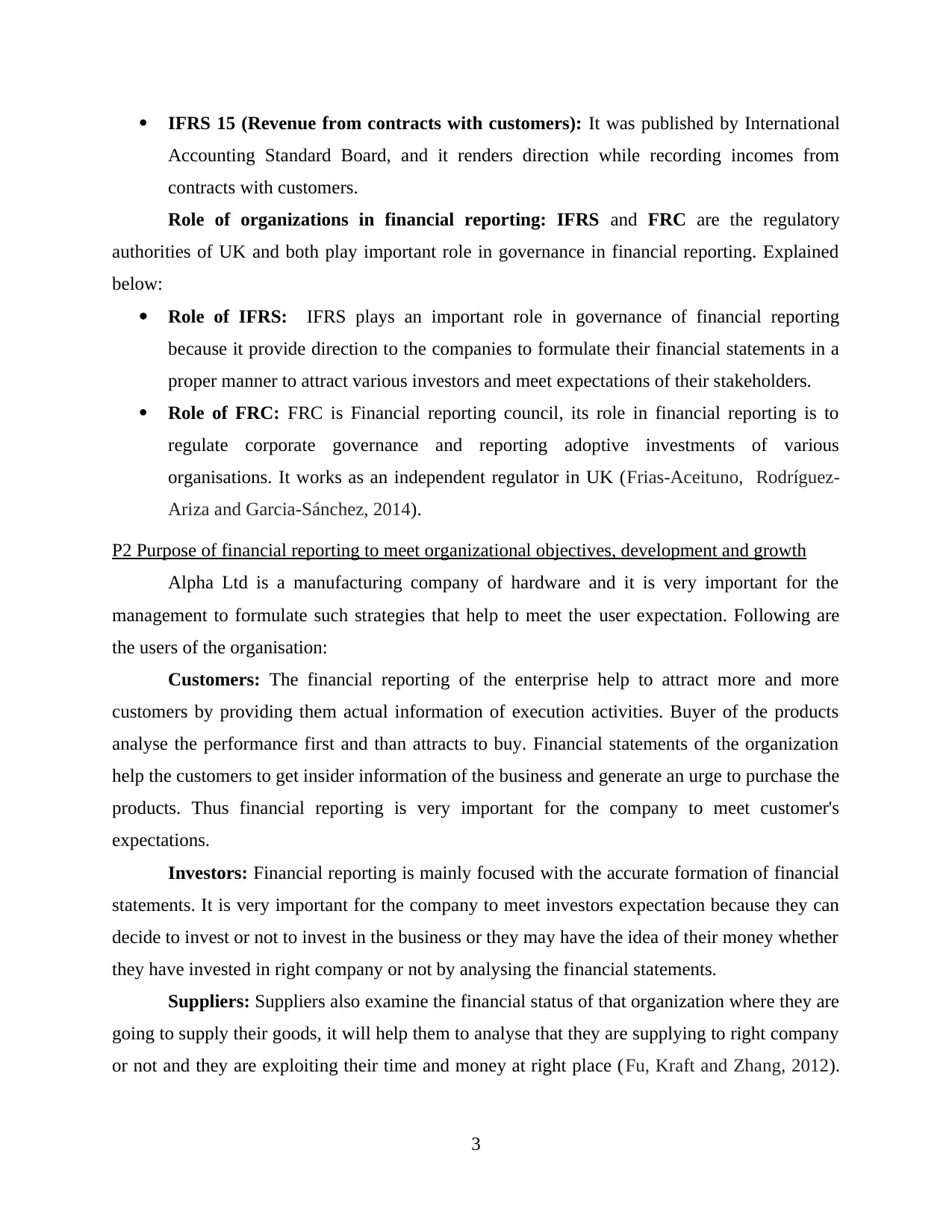
IFRS 15 (Revenue from contracts with customers): It was published by International
Accounting Standard Board, and it renders direction while recording incomes from
contracts with customers.
Role of organizations in financial reporting: IFRS and FRC are the regulatory
authorities of UK and both play important role in governance in financial reporting. Explained
below:
Role of IFRS: IFRS plays an important role in governance of financial reporting
because it provide direction to the companies to formulate their financial statements in a
proper manner to attract various investors and meet expectations of their stakeholders.
Role of FRC: FRC is Financial reporting council, its role in financial reporting is to
regulate corporate governance and reporting adoptive investments of various
organisations. It works as an independent regulator in UK (Frias‐Aceituno, Rodríguez‐
Ariza and Garcia‐Sánchez, 2014).
P2 Purpose of financial reporting to meet organizational objectives, development and growth
Alpha Ltd is a manufacturing company of hardware and it is very important for the
management to formulate such strategies that help to meet the user expectation. Following are
the users of the organisation:
Customers: The financial reporting of the enterprise help to attract more and more
customers by providing them actual information of execution activities. Buyer of the products
analyse the performance first and than attracts to buy. Financial statements of the organization
help the customers to get insider information of the business and generate an urge to purchase the
products. Thus financial reporting is very important for the company to meet customer's
expectations.
Investors: Financial reporting is mainly focused with the accurate formation of financial
statements. It is very important for the company to meet investors expectation because they can
decide to invest or not to invest in the business or they may have the idea of their money whether
they have invested in right company or not by analysing the financial statements.
Suppliers: Suppliers also examine the financial status of that organization where they are
going to supply their goods, it will help them to analyse that they are supplying to right company
or not and they are exploiting their time and money at right place (Fu, Kraft and Zhang, 2012).
3
Accounting Standard Board, and it renders direction while recording incomes from
contracts with customers.
Role of organizations in financial reporting: IFRS and FRC are the regulatory
authorities of UK and both play important role in governance in financial reporting. Explained
below:
Role of IFRS: IFRS plays an important role in governance of financial reporting
because it provide direction to the companies to formulate their financial statements in a
proper manner to attract various investors and meet expectations of their stakeholders.
Role of FRC: FRC is Financial reporting council, its role in financial reporting is to
regulate corporate governance and reporting adoptive investments of various
organisations. It works as an independent regulator in UK (Frias‐Aceituno, Rodríguez‐
Ariza and Garcia‐Sánchez, 2014).
P2 Purpose of financial reporting to meet organizational objectives, development and growth
Alpha Ltd is a manufacturing company of hardware and it is very important for the
management to formulate such strategies that help to meet the user expectation. Following are
the users of the organisation:
Customers: The financial reporting of the enterprise help to attract more and more
customers by providing them actual information of execution activities. Buyer of the products
analyse the performance first and than attracts to buy. Financial statements of the organization
help the customers to get insider information of the business and generate an urge to purchase the
products. Thus financial reporting is very important for the company to meet customer's
expectations.
Investors: Financial reporting is mainly focused with the accurate formation of financial
statements. It is very important for the company to meet investors expectation because they can
decide to invest or not to invest in the business or they may have the idea of their money whether
they have invested in right company or not by analysing the financial statements.
Suppliers: Suppliers also examine the financial status of that organization where they are
going to supply their goods, it will help them to analyse that they are supplying to right company
or not and they are exploiting their time and money at right place (Fu, Kraft and Zhang, 2012).
3
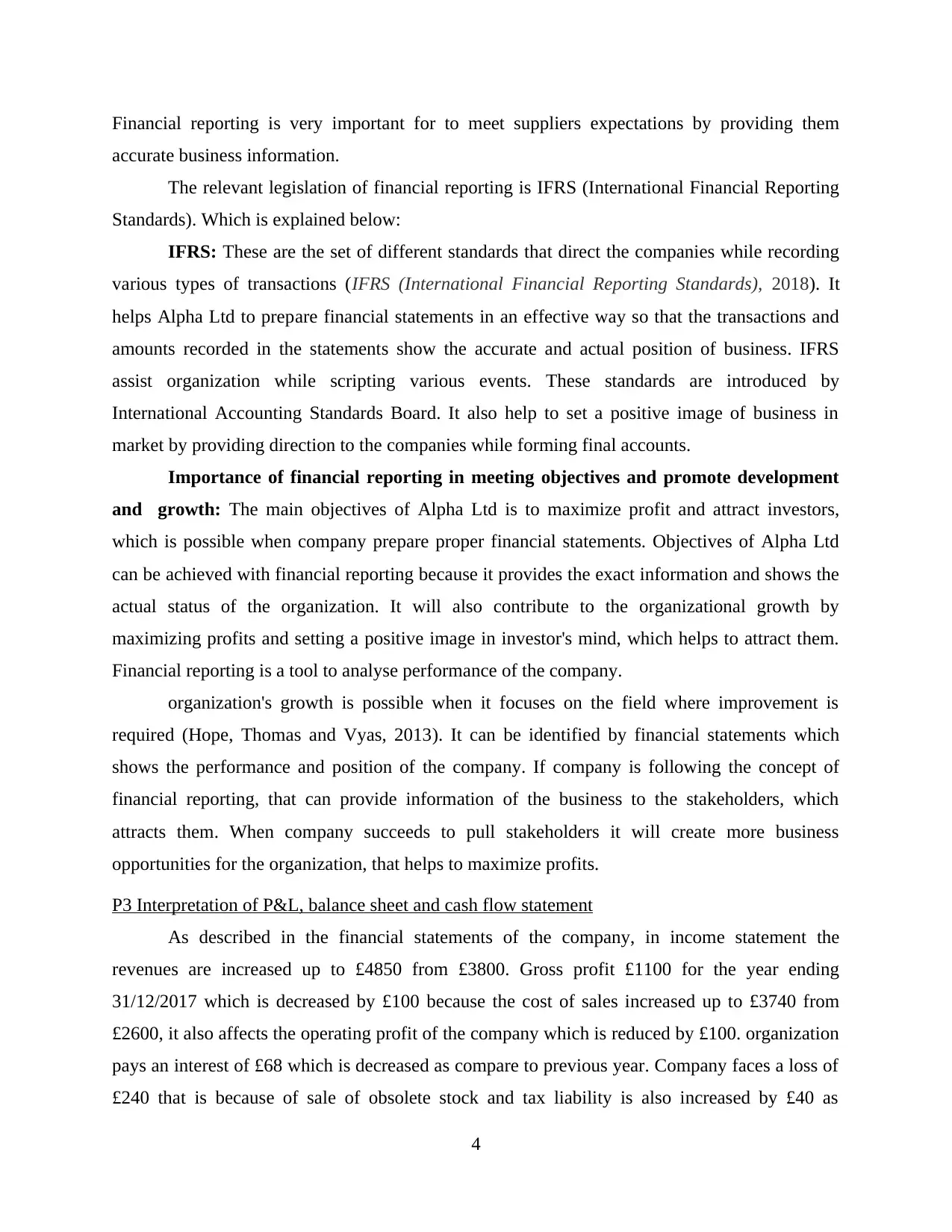
Financial reporting is very important for to meet suppliers expectations by providing them
accurate business information.
The relevant legislation of financial reporting is IFRS (International Financial Reporting
Standards). Which is explained below:
IFRS: These are the set of different standards that direct the companies while recording
various types of transactions (IFRS (International Financial Reporting Standards), 2018). It
helps Alpha Ltd to prepare financial statements in an effective way so that the transactions and
amounts recorded in the statements show the accurate and actual position of business. IFRS
assist organization while scripting various events. These standards are introduced by
International Accounting Standards Board. It also help to set a positive image of business in
market by providing direction to the companies while forming final accounts.
Importance of financial reporting in meeting objectives and promote development
and growth: The main objectives of Alpha Ltd is to maximize profit and attract investors,
which is possible when company prepare proper financial statements. Objectives of Alpha Ltd
can be achieved with financial reporting because it provides the exact information and shows the
actual status of the organization. It will also contribute to the organizational growth by
maximizing profits and setting a positive image in investor's mind, which helps to attract them.
Financial reporting is a tool to analyse performance of the company.
organization's growth is possible when it focuses on the field where improvement is
required (Hope, Thomas and Vyas, 2013). It can be identified by financial statements which
shows the performance and position of the company. If company is following the concept of
financial reporting, that can provide information of the business to the stakeholders, which
attracts them. When company succeeds to pull stakeholders it will create more business
opportunities for the organization, that helps to maximize profits.
P3 Interpretation of P&L, balance sheet and cash flow statement
As described in the financial statements of the company, in income statement the
revenues are increased up to £4850 from £3800. Gross profit £1100 for the year ending
31/12/2017 which is decreased by £100 because the cost of sales increased up to £3740 from
£2600, it also affects the operating profit of the company which is reduced by £100. organization
pays an interest of £68 which is decreased as compare to previous year. Company faces a loss of
£240 that is because of sale of obsolete stock and tax liability is also increased by £40 as
4
accurate business information.
The relevant legislation of financial reporting is IFRS (International Financial Reporting
Standards). Which is explained below:
IFRS: These are the set of different standards that direct the companies while recording
various types of transactions (IFRS (International Financial Reporting Standards), 2018). It
helps Alpha Ltd to prepare financial statements in an effective way so that the transactions and
amounts recorded in the statements show the accurate and actual position of business. IFRS
assist organization while scripting various events. These standards are introduced by
International Accounting Standards Board. It also help to set a positive image of business in
market by providing direction to the companies while forming final accounts.
Importance of financial reporting in meeting objectives and promote development
and growth: The main objectives of Alpha Ltd is to maximize profit and attract investors,
which is possible when company prepare proper financial statements. Objectives of Alpha Ltd
can be achieved with financial reporting because it provides the exact information and shows the
actual status of the organization. It will also contribute to the organizational growth by
maximizing profits and setting a positive image in investor's mind, which helps to attract them.
Financial reporting is a tool to analyse performance of the company.
organization's growth is possible when it focuses on the field where improvement is
required (Hope, Thomas and Vyas, 2013). It can be identified by financial statements which
shows the performance and position of the company. If company is following the concept of
financial reporting, that can provide information of the business to the stakeholders, which
attracts them. When company succeeds to pull stakeholders it will create more business
opportunities for the organization, that helps to maximize profits.
P3 Interpretation of P&L, balance sheet and cash flow statement
As described in the financial statements of the company, in income statement the
revenues are increased up to £4850 from £3800. Gross profit £1100 for the year ending
31/12/2017 which is decreased by £100 because the cost of sales increased up to £3740 from
£2600, it also affects the operating profit of the company which is reduced by £100. organization
pays an interest of £68 which is decreased as compare to previous year. Company faces a loss of
£240 that is because of sale of obsolete stock and tax liability is also increased by £40 as
4
⊘ This is a preview!⊘
Do you want full access?
Subscribe today to unlock all pages.

Trusted by 1+ million students worldwide
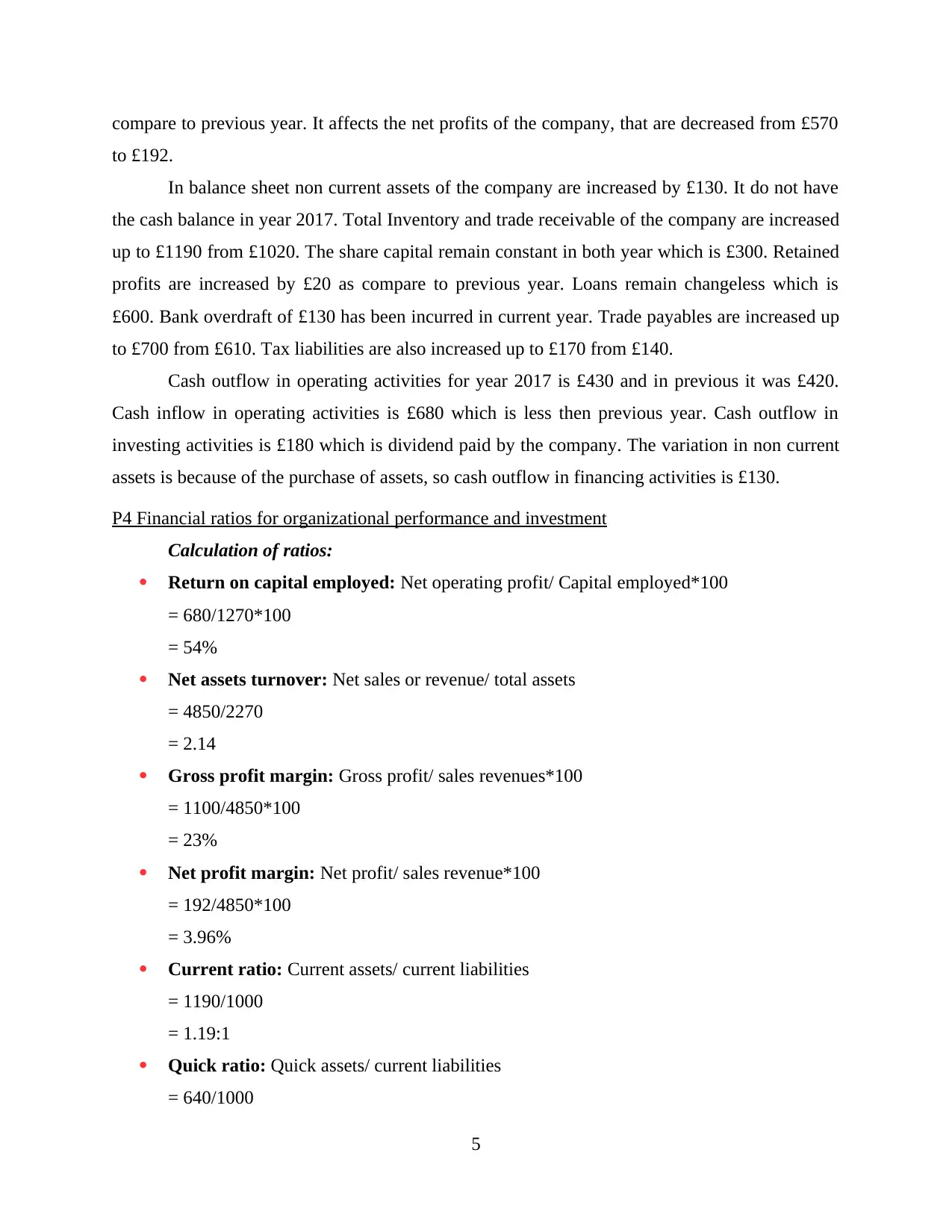
compare to previous year. It affects the net profits of the company, that are decreased from £570
to £192.
In balance sheet non current assets of the company are increased by £130. It do not have
the cash balance in year 2017. Total Inventory and trade receivable of the company are increased
up to £1190 from £1020. The share capital remain constant in both year which is £300. Retained
profits are increased by £20 as compare to previous year. Loans remain changeless which is
£600. Bank overdraft of £130 has been incurred in current year. Trade payables are increased up
to £700 from £610. Tax liabilities are also increased up to £170 from £140.
Cash outflow in operating activities for year 2017 is £430 and in previous it was £420.
Cash inflow in operating activities is £680 which is less then previous year. Cash outflow in
investing activities is £180 which is dividend paid by the company. The variation in non current
assets is because of the purchase of assets, so cash outflow in financing activities is £130.
P4 Financial ratios for organizational performance and investment
Calculation of ratios:
Return on capital employed: Net operating profit/ Capital employed*100
= 680/1270*100
= 54%
Net assets turnover: Net sales or revenue/ total assets
= 4850/2270
= 2.14
Gross profit margin: Gross profit/ sales revenues*100
= 1100/4850*100
= 23%
Net profit margin: Net profit/ sales revenue*100
= 192/4850*100
= 3.96%
Current ratio: Current assets/ current liabilities
= 1190/1000
= 1.19:1
Quick ratio: Quick assets/ current liabilities
= 640/1000
5
to £192.
In balance sheet non current assets of the company are increased by £130. It do not have
the cash balance in year 2017. Total Inventory and trade receivable of the company are increased
up to £1190 from £1020. The share capital remain constant in both year which is £300. Retained
profits are increased by £20 as compare to previous year. Loans remain changeless which is
£600. Bank overdraft of £130 has been incurred in current year. Trade payables are increased up
to £700 from £610. Tax liabilities are also increased up to £170 from £140.
Cash outflow in operating activities for year 2017 is £430 and in previous it was £420.
Cash inflow in operating activities is £680 which is less then previous year. Cash outflow in
investing activities is £180 which is dividend paid by the company. The variation in non current
assets is because of the purchase of assets, so cash outflow in financing activities is £130.
P4 Financial ratios for organizational performance and investment
Calculation of ratios:
Return on capital employed: Net operating profit/ Capital employed*100
= 680/1270*100
= 54%
Net assets turnover: Net sales or revenue/ total assets
= 4850/2270
= 2.14
Gross profit margin: Gross profit/ sales revenues*100
= 1100/4850*100
= 23%
Net profit margin: Net profit/ sales revenue*100
= 192/4850*100
= 3.96%
Current ratio: Current assets/ current liabilities
= 1190/1000
= 1.19:1
Quick ratio: Quick assets/ current liabilities
= 640/1000
5
Paraphrase This Document
Need a fresh take? Get an instant paraphrase of this document with our AI Paraphraser
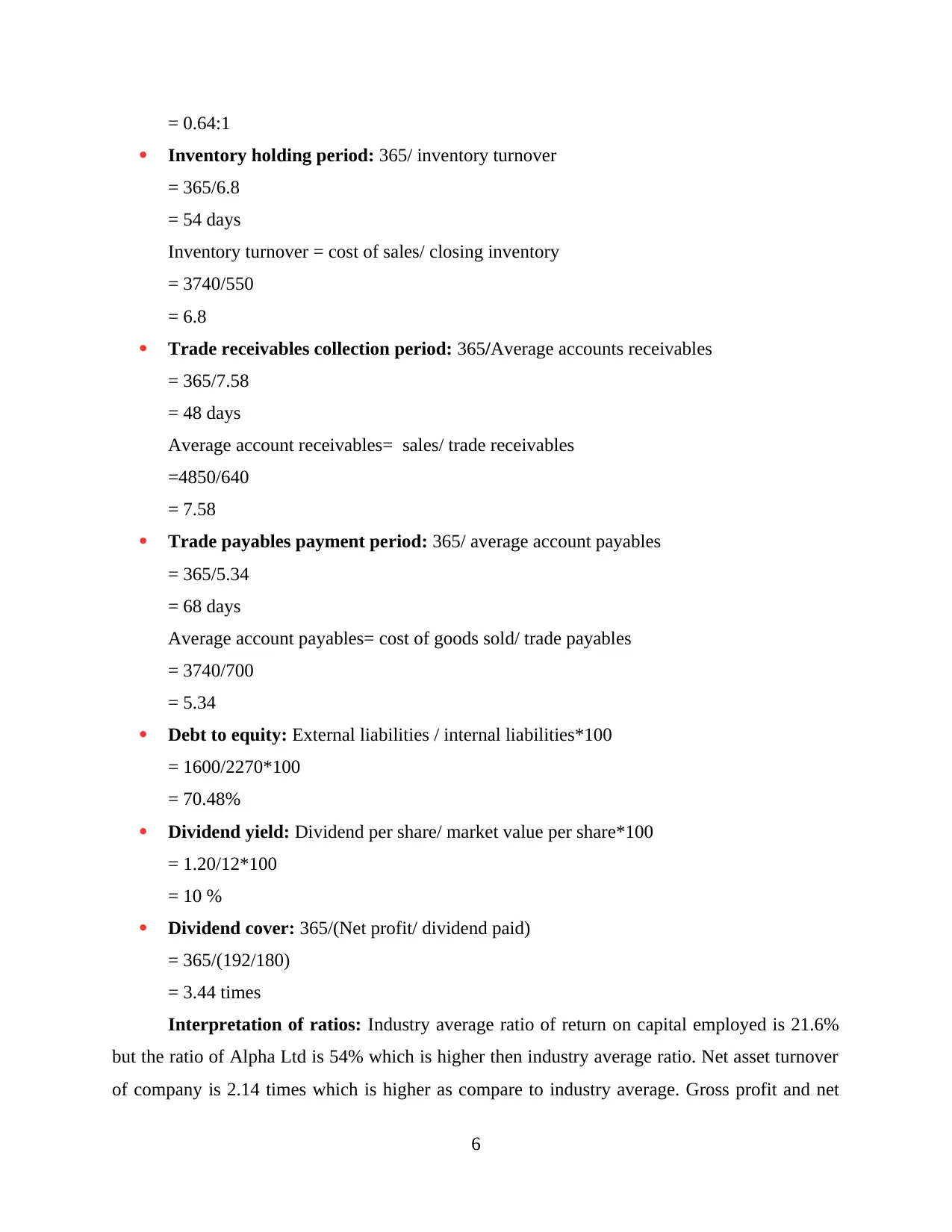
= 0.64:1
Inventory holding period: 365/ inventory turnover
= 365/6.8
= 54 days
Inventory turnover = cost of sales/ closing inventory
= 3740/550
= 6.8
Trade receivables collection period: 365/Average accounts receivables
= 365/7.58
= 48 days
Average account receivables= sales/ trade receivables
=4850/640
= 7.58
Trade payables payment period: 365/ average account payables
= 365/5.34
= 68 days
Average account payables= cost of goods sold/ trade payables
= 3740/700
= 5.34
Debt to equity: External liabilities / internal liabilities*100
= 1600/2270*100
= 70.48%
Dividend yield: Dividend per share/ market value per share*100
= 1.20/12*100
= 10 %
Dividend cover: 365/(Net profit/ dividend paid)
= 365/(192/180)
= 3.44 times
Interpretation of ratios: Industry average ratio of return on capital employed is 21.6%
but the ratio of Alpha Ltd is 54% which is higher then industry average ratio. Net asset turnover
of company is 2.14 times which is higher as compare to industry average. Gross profit and net
6
Inventory holding period: 365/ inventory turnover
= 365/6.8
= 54 days
Inventory turnover = cost of sales/ closing inventory
= 3740/550
= 6.8
Trade receivables collection period: 365/Average accounts receivables
= 365/7.58
= 48 days
Average account receivables= sales/ trade receivables
=4850/640
= 7.58
Trade payables payment period: 365/ average account payables
= 365/5.34
= 68 days
Average account payables= cost of goods sold/ trade payables
= 3740/700
= 5.34
Debt to equity: External liabilities / internal liabilities*100
= 1600/2270*100
= 70.48%
Dividend yield: Dividend per share/ market value per share*100
= 1.20/12*100
= 10 %
Dividend cover: 365/(Net profit/ dividend paid)
= 365/(192/180)
= 3.44 times
Interpretation of ratios: Industry average ratio of return on capital employed is 21.6%
but the ratio of Alpha Ltd is 54% which is higher then industry average ratio. Net asset turnover
of company is 2.14 times which is higher as compare to industry average. Gross profit and net
6
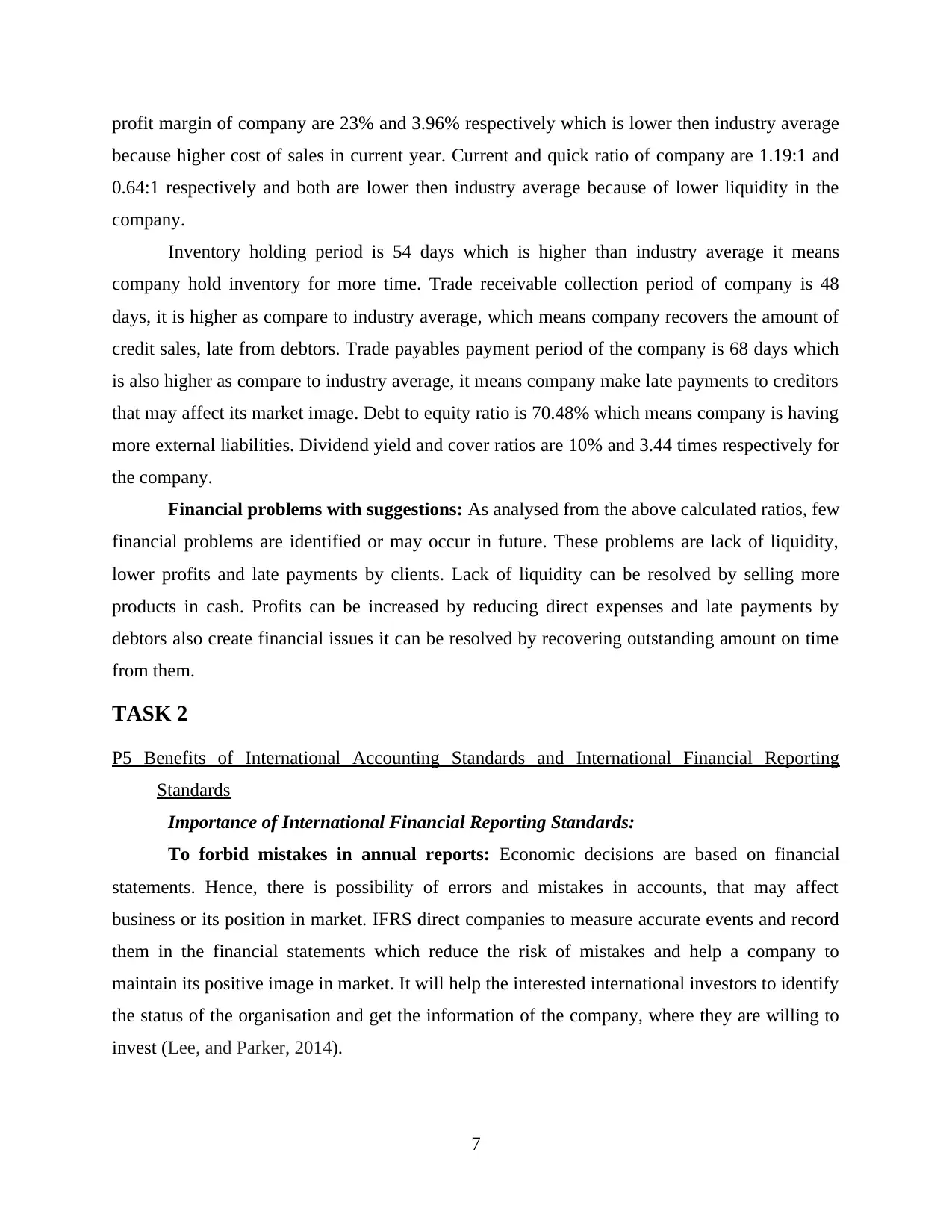
profit margin of company are 23% and 3.96% respectively which is lower then industry average
because higher cost of sales in current year. Current and quick ratio of company are 1.19:1 and
0.64:1 respectively and both are lower then industry average because of lower liquidity in the
company.
Inventory holding period is 54 days which is higher than industry average it means
company hold inventory for more time. Trade receivable collection period of company is 48
days, it is higher as compare to industry average, which means company recovers the amount of
credit sales, late from debtors. Trade payables payment period of the company is 68 days which
is also higher as compare to industry average, it means company make late payments to creditors
that may affect its market image. Debt to equity ratio is 70.48% which means company is having
more external liabilities. Dividend yield and cover ratios are 10% and 3.44 times respectively for
the company.
Financial problems with suggestions: As analysed from the above calculated ratios, few
financial problems are identified or may occur in future. These problems are lack of liquidity,
lower profits and late payments by clients. Lack of liquidity can be resolved by selling more
products in cash. Profits can be increased by reducing direct expenses and late payments by
debtors also create financial issues it can be resolved by recovering outstanding amount on time
from them.
TASK 2
P5 Benefits of International Accounting Standards and International Financial Reporting
Standards
Importance of International Financial Reporting Standards:
To forbid mistakes in annual reports: Economic decisions are based on financial
statements. Hence, there is possibility of errors and mistakes in accounts, that may affect
business or its position in market. IFRS direct companies to measure accurate events and record
them in the financial statements which reduce the risk of mistakes and help a company to
maintain its positive image in market. It will help the interested international investors to identify
the status of the organisation and get the information of the company, where they are willing to
invest (Lee, and Parker, 2014).
7
because higher cost of sales in current year. Current and quick ratio of company are 1.19:1 and
0.64:1 respectively and both are lower then industry average because of lower liquidity in the
company.
Inventory holding period is 54 days which is higher than industry average it means
company hold inventory for more time. Trade receivable collection period of company is 48
days, it is higher as compare to industry average, which means company recovers the amount of
credit sales, late from debtors. Trade payables payment period of the company is 68 days which
is also higher as compare to industry average, it means company make late payments to creditors
that may affect its market image. Debt to equity ratio is 70.48% which means company is having
more external liabilities. Dividend yield and cover ratios are 10% and 3.44 times respectively for
the company.
Financial problems with suggestions: As analysed from the above calculated ratios, few
financial problems are identified or may occur in future. These problems are lack of liquidity,
lower profits and late payments by clients. Lack of liquidity can be resolved by selling more
products in cash. Profits can be increased by reducing direct expenses and late payments by
debtors also create financial issues it can be resolved by recovering outstanding amount on time
from them.
TASK 2
P5 Benefits of International Accounting Standards and International Financial Reporting
Standards
Importance of International Financial Reporting Standards:
To forbid mistakes in annual reports: Economic decisions are based on financial
statements. Hence, there is possibility of errors and mistakes in accounts, that may affect
business or its position in market. IFRS direct companies to measure accurate events and record
them in the financial statements which reduce the risk of mistakes and help a company to
maintain its positive image in market. It will help the interested international investors to identify
the status of the organisation and get the information of the company, where they are willing to
invest (Lee, and Parker, 2014).
7
⊘ This is a preview!⊘
Do you want full access?
Subscribe today to unlock all pages.

Trusted by 1+ million students worldwide
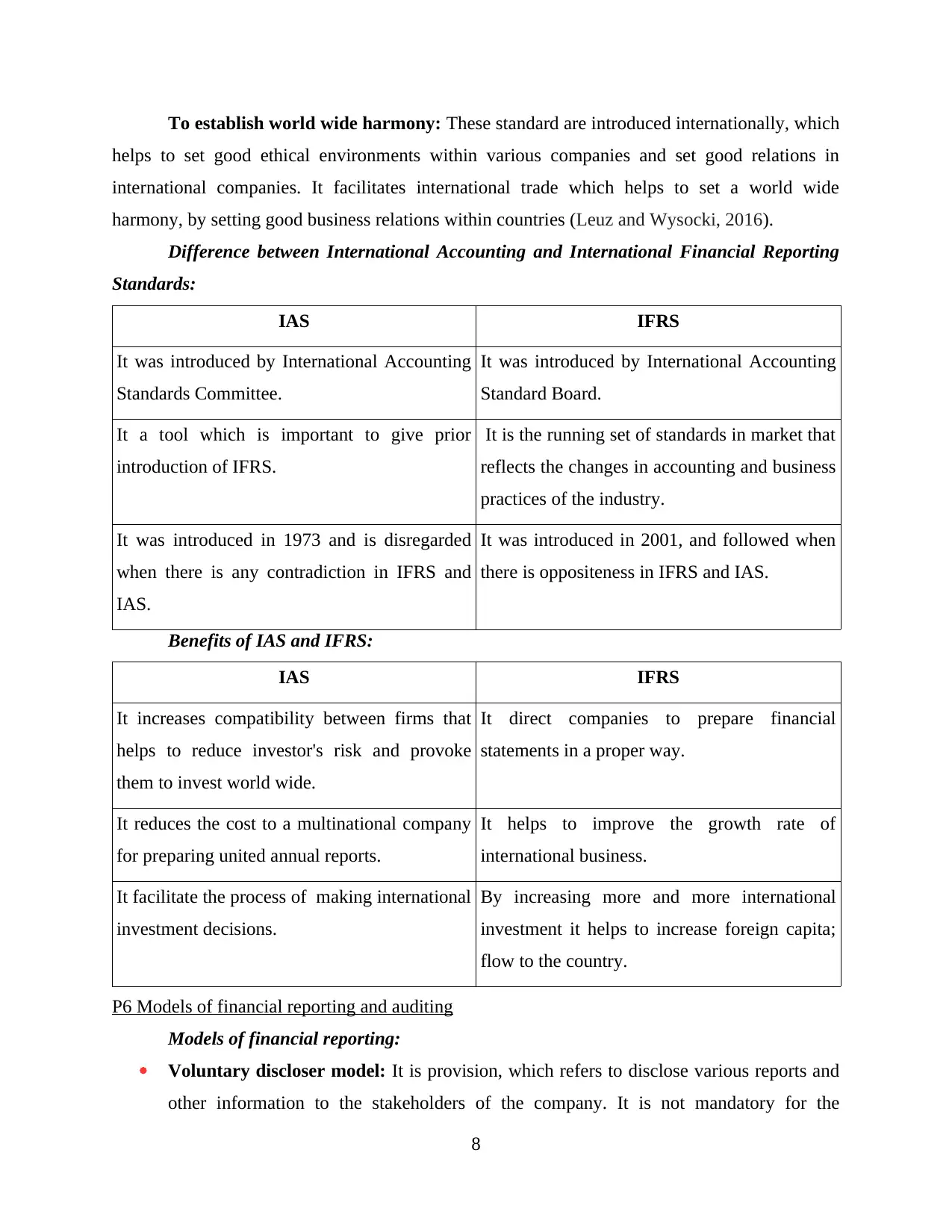
To establish world wide harmony: These standard are introduced internationally, which
helps to set good ethical environments within various companies and set good relations in
international companies. It facilitates international trade which helps to set a world wide
harmony, by setting good business relations within countries (Leuz and Wysocki, 2016).
Difference between International Accounting and International Financial Reporting
Standards:
IAS IFRS
It was introduced by International Accounting
Standards Committee.
It was introduced by International Accounting
Standard Board.
It a tool which is important to give prior
introduction of IFRS.
It is the running set of standards in market that
reflects the changes in accounting and business
practices of the industry.
It was introduced in 1973 and is disregarded
when there is any contradiction in IFRS and
IAS.
It was introduced in 2001, and followed when
there is oppositeness in IFRS and IAS.
Benefits of IAS and IFRS:
IAS IFRS
It increases compatibility between firms that
helps to reduce investor's risk and provoke
them to invest world wide.
It direct companies to prepare financial
statements in a proper way.
It reduces the cost to a multinational company
for preparing united annual reports.
It helps to improve the growth rate of
international business.
It facilitate the process of making international
investment decisions.
By increasing more and more international
investment it helps to increase foreign capita;
flow to the country.
P6 Models of financial reporting and auditing
Models of financial reporting:
Voluntary discloser model: It is provision, which refers to disclose various reports and
other information to the stakeholders of the company. It is not mandatory for the
8
helps to set good ethical environments within various companies and set good relations in
international companies. It facilitates international trade which helps to set a world wide
harmony, by setting good business relations within countries (Leuz and Wysocki, 2016).
Difference between International Accounting and International Financial Reporting
Standards:
IAS IFRS
It was introduced by International Accounting
Standards Committee.
It was introduced by International Accounting
Standard Board.
It a tool which is important to give prior
introduction of IFRS.
It is the running set of standards in market that
reflects the changes in accounting and business
practices of the industry.
It was introduced in 1973 and is disregarded
when there is any contradiction in IFRS and
IAS.
It was introduced in 2001, and followed when
there is oppositeness in IFRS and IAS.
Benefits of IAS and IFRS:
IAS IFRS
It increases compatibility between firms that
helps to reduce investor's risk and provoke
them to invest world wide.
It direct companies to prepare financial
statements in a proper way.
It reduces the cost to a multinational company
for preparing united annual reports.
It helps to improve the growth rate of
international business.
It facilitate the process of making international
investment decisions.
By increasing more and more international
investment it helps to increase foreign capita;
flow to the country.
P6 Models of financial reporting and auditing
Models of financial reporting:
Voluntary discloser model: It is provision, which refers to disclose various reports and
other information to the stakeholders of the company. It is not mandatory for the
8
Paraphrase This Document
Need a fresh take? Get an instant paraphrase of this document with our AI Paraphraser
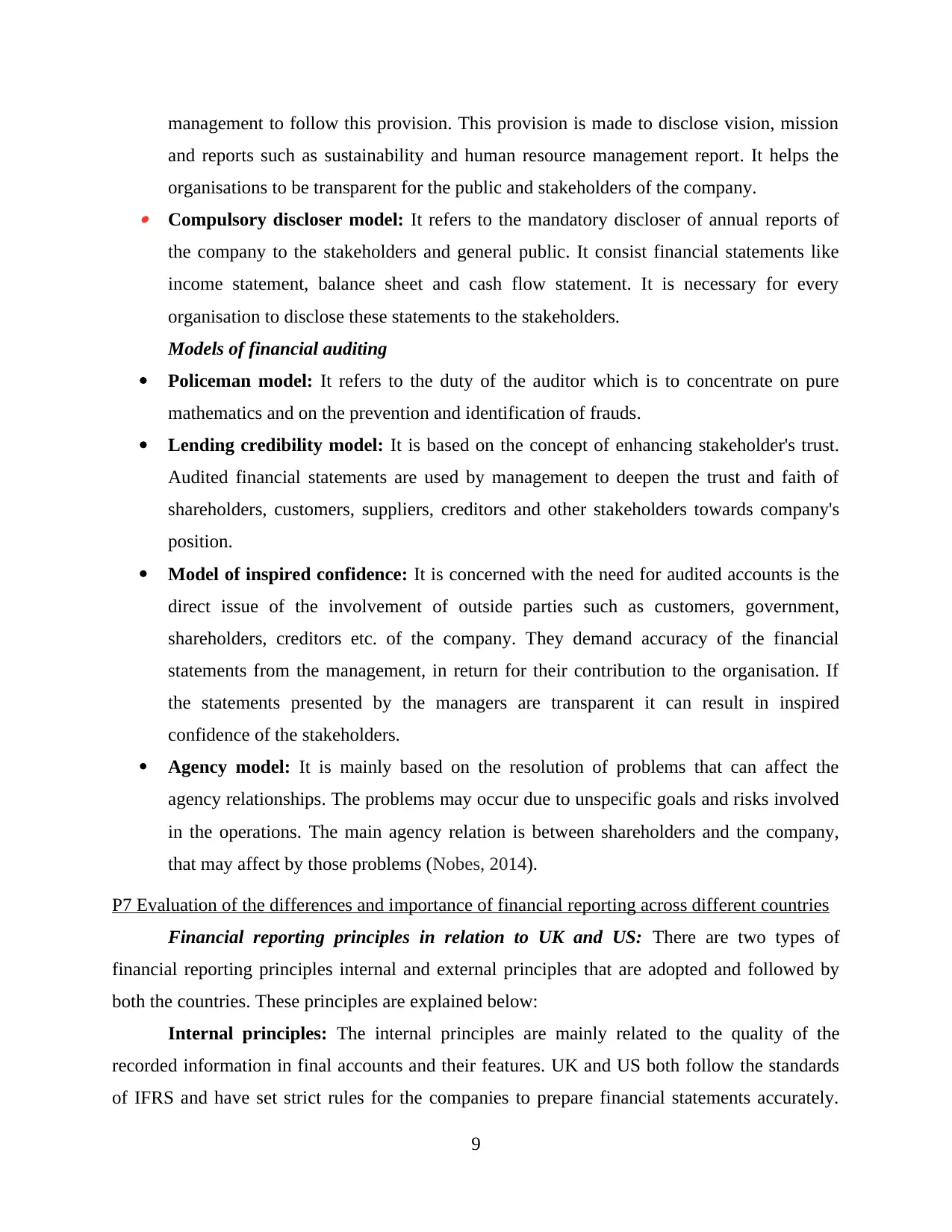
management to follow this provision. This provision is made to disclose vision, mission
and reports such as sustainability and human resource management report. It helps the
organisations to be transparent for the public and stakeholders of the company. Compulsory discloser model: It refers to the mandatory discloser of annual reports of
the company to the stakeholders and general public. It consist financial statements like
income statement, balance sheet and cash flow statement. It is necessary for every
organisation to disclose these statements to the stakeholders.
Models of financial auditing
Policeman model: It refers to the duty of the auditor which is to concentrate on pure
mathematics and on the prevention and identification of frauds.
Lending credibility model: It is based on the concept of enhancing stakeholder's trust.
Audited financial statements are used by management to deepen the trust and faith of
shareholders, customers, suppliers, creditors and other stakeholders towards company's
position.
Model of inspired confidence: It is concerned with the need for audited accounts is the
direct issue of the involvement of outside parties such as customers, government,
shareholders, creditors etc. of the company. They demand accuracy of the financial
statements from the management, in return for their contribution to the organisation. If
the statements presented by the managers are transparent it can result in inspired
confidence of the stakeholders.
Agency model: It is mainly based on the resolution of problems that can affect the
agency relationships. The problems may occur due to unspecific goals and risks involved
in the operations. The main agency relation is between shareholders and the company,
that may affect by those problems (Nobes, 2014).
P7 Evaluation of the differences and importance of financial reporting across different countries
Financial reporting principles in relation to UK and US: There are two types of
financial reporting principles internal and external principles that are adopted and followed by
both the countries. These principles are explained below:
Internal principles: The internal principles are mainly related to the quality of the
recorded information in final accounts and their features. UK and US both follow the standards
of IFRS and have set strict rules for the companies to prepare financial statements accurately.
9
and reports such as sustainability and human resource management report. It helps the
organisations to be transparent for the public and stakeholders of the company. Compulsory discloser model: It refers to the mandatory discloser of annual reports of
the company to the stakeholders and general public. It consist financial statements like
income statement, balance sheet and cash flow statement. It is necessary for every
organisation to disclose these statements to the stakeholders.
Models of financial auditing
Policeman model: It refers to the duty of the auditor which is to concentrate on pure
mathematics and on the prevention and identification of frauds.
Lending credibility model: It is based on the concept of enhancing stakeholder's trust.
Audited financial statements are used by management to deepen the trust and faith of
shareholders, customers, suppliers, creditors and other stakeholders towards company's
position.
Model of inspired confidence: It is concerned with the need for audited accounts is the
direct issue of the involvement of outside parties such as customers, government,
shareholders, creditors etc. of the company. They demand accuracy of the financial
statements from the management, in return for their contribution to the organisation. If
the statements presented by the managers are transparent it can result in inspired
confidence of the stakeholders.
Agency model: It is mainly based on the resolution of problems that can affect the
agency relationships. The problems may occur due to unspecific goals and risks involved
in the operations. The main agency relation is between shareholders and the company,
that may affect by those problems (Nobes, 2014).
P7 Evaluation of the differences and importance of financial reporting across different countries
Financial reporting principles in relation to UK and US: There are two types of
financial reporting principles internal and external principles that are adopted and followed by
both the countries. These principles are explained below:
Internal principles: The internal principles are mainly related to the quality of the
recorded information in final accounts and their features. UK and US both follow the standards
of IFRS and have set strict rules for the companies to prepare financial statements accurately.
9
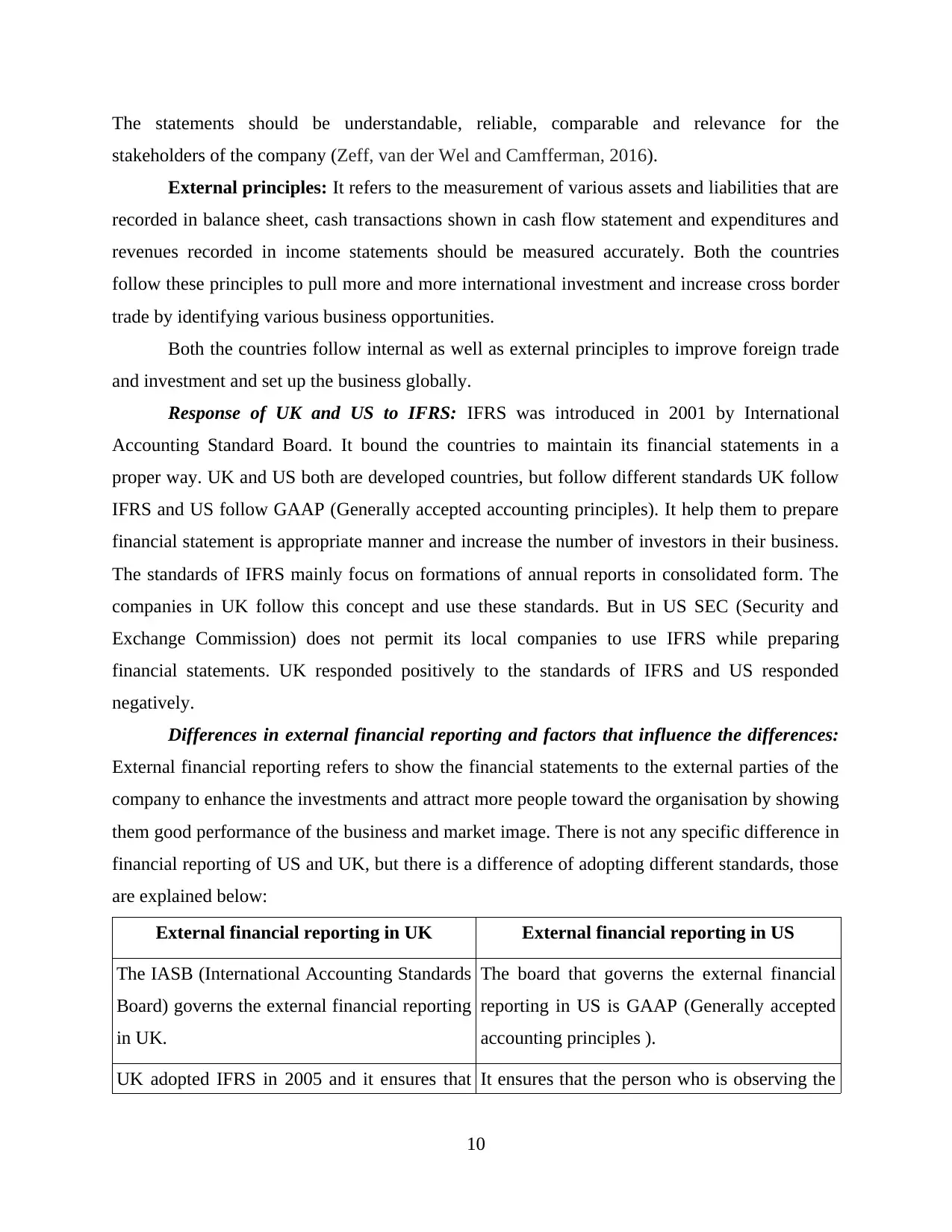
The statements should be understandable, reliable, comparable and relevance for the
stakeholders of the company (Zeff, van der Wel and Camfferman, 2016).
External principles: It refers to the measurement of various assets and liabilities that are
recorded in balance sheet, cash transactions shown in cash flow statement and expenditures and
revenues recorded in income statements should be measured accurately. Both the countries
follow these principles to pull more and more international investment and increase cross border
trade by identifying various business opportunities.
Both the countries follow internal as well as external principles to improve foreign trade
and investment and set up the business globally.
Response of UK and US to IFRS: IFRS was introduced in 2001 by International
Accounting Standard Board. It bound the countries to maintain its financial statements in a
proper way. UK and US both are developed countries, but follow different standards UK follow
IFRS and US follow GAAP (Generally accepted accounting principles). It help them to prepare
financial statement is appropriate manner and increase the number of investors in their business.
The standards of IFRS mainly focus on formations of annual reports in consolidated form. The
companies in UK follow this concept and use these standards. But in US SEC (Security and
Exchange Commission) does not permit its local companies to use IFRS while preparing
financial statements. UK responded positively to the standards of IFRS and US responded
negatively.
Differences in external financial reporting and factors that influence the differences:
External financial reporting refers to show the financial statements to the external parties of the
company to enhance the investments and attract more people toward the organisation by showing
them good performance of the business and market image. There is not any specific difference in
financial reporting of US and UK, but there is a difference of adopting different standards, those
are explained below:
External financial reporting in UK External financial reporting in US
The IASB (International Accounting Standards
Board) governs the external financial reporting
in UK.
The board that governs the external financial
reporting in US is GAAP (Generally accepted
accounting principles ).
UK adopted IFRS in 2005 and it ensures that It ensures that the person who is observing the
10
stakeholders of the company (Zeff, van der Wel and Camfferman, 2016).
External principles: It refers to the measurement of various assets and liabilities that are
recorded in balance sheet, cash transactions shown in cash flow statement and expenditures and
revenues recorded in income statements should be measured accurately. Both the countries
follow these principles to pull more and more international investment and increase cross border
trade by identifying various business opportunities.
Both the countries follow internal as well as external principles to improve foreign trade
and investment and set up the business globally.
Response of UK and US to IFRS: IFRS was introduced in 2001 by International
Accounting Standard Board. It bound the countries to maintain its financial statements in a
proper way. UK and US both are developed countries, but follow different standards UK follow
IFRS and US follow GAAP (Generally accepted accounting principles). It help them to prepare
financial statement is appropriate manner and increase the number of investors in their business.
The standards of IFRS mainly focus on formations of annual reports in consolidated form. The
companies in UK follow this concept and use these standards. But in US SEC (Security and
Exchange Commission) does not permit its local companies to use IFRS while preparing
financial statements. UK responded positively to the standards of IFRS and US responded
negatively.
Differences in external financial reporting and factors that influence the differences:
External financial reporting refers to show the financial statements to the external parties of the
company to enhance the investments and attract more people toward the organisation by showing
them good performance of the business and market image. There is not any specific difference in
financial reporting of US and UK, but there is a difference of adopting different standards, those
are explained below:
External financial reporting in UK External financial reporting in US
The IASB (International Accounting Standards
Board) governs the external financial reporting
in UK.
The board that governs the external financial
reporting in US is GAAP (Generally accepted
accounting principles ).
UK adopted IFRS in 2005 and it ensures that It ensures that the person who is observing the
10
⊘ This is a preview!⊘
Do you want full access?
Subscribe today to unlock all pages.

Trusted by 1+ million students worldwide
1 out of 16
Related Documents
Your All-in-One AI-Powered Toolkit for Academic Success.
+13062052269
info@desklib.com
Available 24*7 on WhatsApp / Email
![[object Object]](/_next/static/media/star-bottom.7253800d.svg)
Unlock your academic potential
Copyright © 2020–2025 A2Z Services. All Rights Reserved. Developed and managed by ZUCOL.





